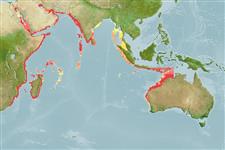Elasmobranchii (sharks and rays) >
Torpediniformes (Electric rays) >
Torpedinidae (Electric rays)
Etymology: Torpedo: Latin, torpere = be sluggish (Ref. 45335).
Environment / Climate / Range
Ecology
Marine; brackish; reef-associated; depth range 1 - 200 m (Ref. 9710). Tropical, preferred ?; 30°N - 31°S, 29°E - 95°E
Western Indian Ocean: Persian Gulf (Ref. 80050), Red Sea eastward to India (Ref. 2712) and southward to Natal, South Africa (Ref. 5578).
Size / Weight / Age
Maturity: Lm ? range ? - ? cm
Max length : 130 cm TL male/unsexed; (Ref. 2712)
Short description
Morphology | Morphometrics
Large ray with a small caudal fin and with papillae around the spiracles (Ref. 5578). Bright color pattern of circles and irregular marks, cream or golden on dark red or brown to blackish background dorsally (Ref. 5578).
Found inshore in sandy bottoms, and well offshore from the surf zone down to 200 m (Ref. 5578). Also on or near coral reefs (Ref. 12951). Common in shallow sandy areas (Ref. 2712). Feeds on bony fishes (Ref. 12951). Ovoviviparous (Ref. 50449). Occurs singly but may form groups during the breeding season (Ref. 12951). Occasionally hooked by anglers, more often seen by divers; can deliver a strong shock (Ref. 2712). Flesh is edible (Ref. 12484). Can survive for hours after being stranded on the beach (Ref. 41394).
Life cycle and mating behavior
Maturity | Reproduction | Spawning | Eggs | Fecundity | Larvae
Exhibit ovoviparity (aplacental viviparity), with embryos feeding initially on yolk, then receiving additional nourishment from the mother by indirect absorption of uterine fluid enriched with mucus, fat or protein through specialised structures (Ref. 50449). With 9-22 in a litter (Ref. 12951). Form aggregations during the reproductive season (Ref. 41394).
Compagno, L.J.V., 1986. Torpedinidae. p. 112-113. In M.M. Smith and P.C. Heemstra (eds.) Smiths' sea fishes. Springer-Verlag, Berlin. (Ref. 2712)
IUCN Red List Status (Ref. 115185)
CITES (Ref. 94142)
Not Evaluated
Human uses
Gamefish: yes
More information
ReferencesAquacultureAquaculture profileStrainsGeneticsAllele frequenciesHeritabilityDiseasesProcessingMass conversion
Tools
Special reports
Download XML
Internet sources
